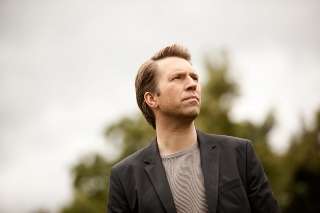|
Back
A Trio of Quartets New York
Isaac Stern Auditorium, Carnegie Hall
04/09/2016 - & April 7 (Chapel Hill), 10 (Chicago), 2016
Johannes Brahms: Piano Quartets No. 1 in G Minor, opus 25, No. 2 in A Major, opus 26, & No. 3 in C Minor, opus 60
Leif Ove Andsnes (piano), James Ehnes (violin), Tabea Zimmermann (viola), Clemens Hagen (cello)

L. O. Andsnes (© Ozgür Albayrak)
“Now imagine a man who is just going to shoot himself, because nothing else remains for him to do.”
Brahms
New Yorkers are justifiably proud that the first ever chamber composition written by Brahms was premiered not in Germany nor Austria but rather right here in a long vanished concert hall in what is now our Chinatown. The B Major Trio was the first instance where the young composer began to explore the thickness of the combination of strings and piano which would lead to the most amazing works of musical architecture wherein three, four or five instruments sounded like full orchestras in their structural complexity. The three piano quartets are superb examples of this sonic legerdemain and at Carnegie Hall we were treated to a full evening of the densest chamber music prior to that of Max Reger or Charles Ives, so dense that when Arnold Schoenberg was approached by his friend and colleague Otto Klemperer to arrange the G Minor Quartet for his orchestra that performed at the Hollywood Bowl, the Viennese composer, who once earned his living as a cellist back home in a quartet led by Fritz Kreisler and was quite familiar with the piece, jumped at the chance.
Stern Auditorium is a very big room, but still fits the metaphor of the elephant within it. Dealing with this problem at the outset, it must be stated that Leif Ove Andsnes is a strange choice to lead this particular program. Mr. Andsnes is a fine pianist with a reputation for highly accurate and delicate performances, each note a perfect enunciation in its exact spot, the personality of the player subsumed by the limpidity of the practitioner’s technique. Highly praiseworthy, but the opposite of the performing style of Brahms himself. By all accounts, the Hamburg master was an ebullient keyboardist, loud, boisterous and extremely energetic, emphasizing the weight of the piano timbre in all of its glory. This evening’s quartets, especially the first and third, were composed with this anchoring role in mind.
Thus Andsnes seemed out of his element almost immediately. His pianissimos, of which he is fond, were subsumed by the cavernous hall, leaving listeners having to supply them through their inner ears and memories. The second movement of the First Quartet was faster than normal but not sloppy, except for some uncharacteristic fat-fingerings from the keyboard. The group as a whole could never seem to make up their collective mind as to whether to enunciate in a lovely or dramatic manner. Mr. Hagen exhibited a fine and unashamed vibrato throughout. The finale, the delicious zingarese movement, “hid its light under a bushel”, the final presto much slower than many more highly exciting readings of the past.
Robert Schumann called Beethoven’s Fourth Symphony “the fair maiden between two giants”, but that same description is also very apt for Brahms’ Second Piano Quartet. Not surprisingly this was the best reading of the night, a work much more in Mr. Andsnes’ wheelhouse. Although some of us might have wished for more vibrato, even portamento in spots, this was a lovely rendition that only raveled in the final movement, sounding a bit strained and rushed.
Out of the raging fire of youthful lust for Clara Schumann, Brahms poured out his heart and soul into the two movements of what would eventually become the Third and final piano quartet. Many years later when he returned to finish the work, the master composer was still deeply affected by its emotion and fashioned a musical essay that describes in excruciating detail the process of taming the beast of gnawing depression and suicidal tendency, even requesting from his publisher a commitment to print a portrait of Werther on the score’s cover.
Perhaps the players were a bit tired once they embarked on the Third Quartet (this reviewer certainly was) and I realize that we can’t expect Serkin or Casals on a quotidian basis, but the deep emotion of the C Minor Quartet, arguably Brahms’ greatest piece of chamber music, was simply missing in action. This reading was much too foursquare and it was difficult to believe that any of these people had ever experienced such emotional upheaval in their own lives. The scherzo suffered from the pianist’s terminal shyness. The enunciations of Mr. Hagen in the Andante were good – not Sharon Robinson good, but good nonetheless – while the fiddles were simply playing in too straightforward a manner to express such intense passages with the catastrophic urgency that the composer required. A disappointing evening.
This event was the annual memorial concert honoring Isaac Stern. I knew Mr. Stern tangentially and he was without question a world class son of a... gun. If he had not been so abrasive there would now be a parking garage on the corner of 57th Street and 7th Avenue.
Fred Kirshnit
|